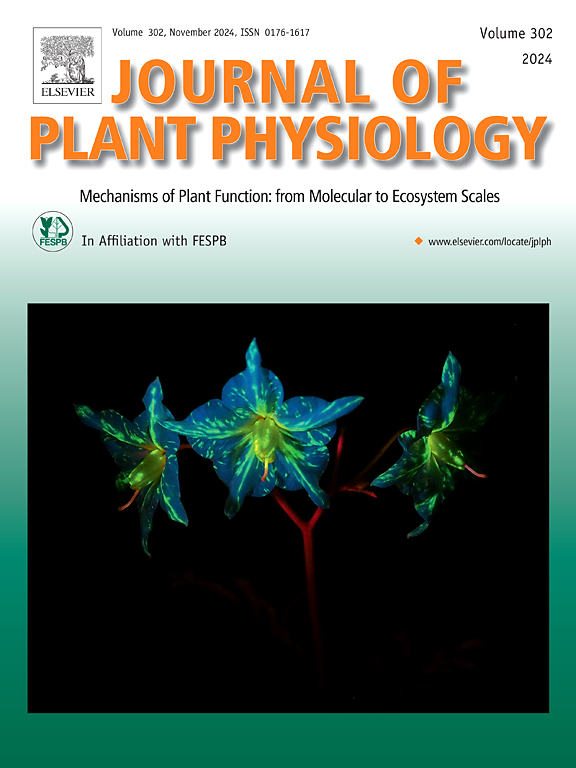Rapid changes in stress-related gene expression after short exposure of Arabidopsis leaves to cold plasma
IF 4
3区 生物学
Q1 PLANT SCIENCES
引用次数: 0
Abstract
Cold Atmospheric Plasma (CAP) technology has emerged as a promising tool in various biological applications due to its ability to generate a composite signal comprising reactive oxygen and nitrogen species, ultraviolet radiation, and electromagnetic fields, all while maintaining a stable temperature. Although CAP treatments have demonstrated significant effects on seed germination and plant growth, the direct molecular responses of plants to CAP exposure remain poorly understood. In this study, young Arabidopsis thaliana leaves were exposed to a brief 5- or 30-s localized CAP treatment, resulting in rapid and localized tissue damage without causing lethal effects on the entire plant. Molecular analyses conducted on the entire plant rosette revealed a notable increase in hydrogen peroxide levels, along with the upregulation of stress-related genes, akin to a wound response. Of particular interest, the activation of RelA/SpoT Homolog (RSH) genes encoding proteins that regulate the synthesis of the stress marker (p)ppGpp, also known as alarmone, and playing a major role in the energic regulation of photosynthesis, occurred shortly after CAP exposure. The expression of RSH genes was up-regulated after 5s CAP exposure, while the wound stress marker ZAT12 remained unaffected, highlighting a specific signalling pathway to activate RSH genes. This finding suggests the potential involvement of the alarmone signalling pathway in the plant's response to CAP exposure, thereby opening avenues for further exploration of metabolic pathways and signalling cascades induced by CAP treatment.

拟南芥叶片短时间暴露于冷血浆后应激相关基因表达的快速变化
冷大气等离子体(CAP)技术由于能够产生包含活性氧和活性氮、紫外线辐射和电磁场的复合信号,同时保持稳定的温度,已成为各种生物应用中有前途的工具。尽管CAP处理已证明对种子萌发和植物生长有显著影响,但植物对CAP暴露的直接分子反应仍知之甚少。在本研究中,拟南芥幼嫩叶片暴露于短暂的5或30 s局部CAP处理下,导致快速和局部组织损伤,而不会对整个植物造成致命影响。对整个植株莲座进行的分子分析显示,过氧化氢水平显著增加,与压力相关的基因也出现上调,类似于伤口反应。特别有趣的是,在暴露于CAP后不久,RelA/SpoT同源基因(RSH)的激活就发生了,这些基因编码调节应激标记物(p)ppGpp(也称为警报酮)合成的蛋白质,并在光合作用的能量调节中发挥重要作用。暴露于CAP 5秒后,RSH基因的表达上调,而伤口应激标记物ZAT12未受影响,这表明激活RSH基因的特定信号通路。这一发现表明,警示信号通路可能参与植物对CAP暴露的反应,从而为进一步探索CAP处理诱导的代谢途径和信号级联通路开辟了道路。
本文章由计算机程序翻译,如有差异,请以英文原文为准。
求助全文
约1分钟内获得全文
求助全文
来源期刊

Journal of plant physiology
生物-植物科学
CiteScore
7.20
自引率
4.70%
发文量
196
审稿时长
32 days
期刊介绍:
The Journal of Plant Physiology is a broad-spectrum journal that welcomes high-quality submissions in all major areas of plant physiology, including plant biochemistry, functional biotechnology, computational and synthetic plant biology, growth and development, photosynthesis and respiration, transport and translocation, plant-microbe interactions, biotic and abiotic stress. Studies are welcome at all levels of integration ranging from molecules and cells to organisms and their environments and are expected to use state-of-the-art methodologies. Pure gene expression studies are not within the focus of our journal. To be considered for publication, papers must significantly contribute to the mechanistic understanding of physiological processes, and not be merely descriptive, or confirmatory of previous results. We encourage the submission of papers that explore the physiology of non-model as well as accepted model species and those that bridge basic and applied research. For instance, studies on agricultural plants that show new physiological mechanisms to improve agricultural efficiency are welcome. Studies performed under uncontrolled situations (e.g. field conditions) not providing mechanistic insight will not be considered for publication.
The Journal of Plant Physiology publishes several types of articles: Original Research Articles, Reviews, Perspectives Articles, and Short Communications. Reviews and Perspectives will be solicited by the Editors; unsolicited reviews are also welcome but only from authors with a strong track record in the field of the review. Original research papers comprise the majority of published contributions.
 求助内容:
求助内容: 应助结果提醒方式:
应助结果提醒方式:


